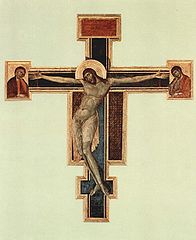Using Symbols

Symbols in Church History
In the history of the Church, symbols have been a way to communicate secretly during times of oppression, a way to teach a particular part of the story of salvation, and a way to remember and celebrate a particular aspect of God's love.
What little we know of the images used by early Christians is what we can deduce from the use of images in the catacombs as decorations on their tombs. Many of the early images were borrowed from pagan symbolism to communicate an idea within Christian theology. Much as you might borrow a word from another language to express an idea that didn't have an English word. For instance it is not uncommon to find a peacock on an early Christian tomb. We believe that the peacock was used as a symbol of life after death since it was occasionally used as such by pagan artists. In most cases, however, the symbols used by the early church were the same as those used in our worship today.
Symbols Related to Jesus
In Christianity, the most common symbol is the cross where Jesus died, but even the cross has several different categories of symbols within it. When the cross is seen in its simplest form it reminds us of the whole work of Jesus in our salvation. It reminds us of his death, the fact that it is empty reminds us of his resurrection, the vertical piece reminds us that Jesus became a bridge between God and humanity, and the horizontal piece reminds us that he links us with all humans in all times and places.

Since the days of the early church, artists decorating worship spaces or items to be used in worship use a variety of symbols to depict Jesus. He is depicted as a lamb because of the lamb served at the Passover meal; he is depicted as a fish because the Greek letters for fish (Ιχθυς) could stand for the phrase "Jesus Christ, God's Son, Savior."
During the Middle Ages, Christ was frequently depicted as a pelican because of the belief that in times of drought or famine a mother pelican would gash open her chest to feed her chicks with her own blood rather than let them starve. This image was particularly popular in embroidery for altar cloths and vestments to be used at communion.
Symbols for the Apostles

- Peter (bearded, keys, upside down cross)
- John the Evangelist (eagle with a gospel book, no beard)
- Andrew (X-shaped cross)
- Thomas (carpenter's square and spear)
- Mary the mother of Jesus (young, wearing a blue gown)
- Mary Magdalene (ointment jar, long hair)
- Matthew (a man or an angel with a gospel book)
- Mark (lion with a gospel book)
- Luke (bull with a gospel book)
- Paul (sword, book)
- John the Baptist (wearing leather or fur, carrying a lamb)
- Martha the sister of Mary and Lazarus (broom)
Other Symbols
Other common symbols are wheat and grapes or a loaf of bread and a cup or chalice. These symbols remind us of celebration of the Lord's Table and the community of faith we recognize and are a part of when we participate in that meal. Also common are depictions of the Church as a boat or ship or as just an anchor since the church carries us across the stormy seas of life.
Liturgical Seasons and Colors
The recognition of liturgical seasons in the church developed gradually around the celebration of Easter and Pentecost. These festivals were related to the Jewish liturgical year since Passover and Pentecost were both Jewish observances. One of the earliest purely Christian celebrations that we would recognize today was of the Epiphany the visit of the magi and the revelation of Jesus to the gentile world. By the Fourth Century we have some mention of a period of fasting before Easter and the recognition of forty days of preparation. The use of colors in the church in a recognized pattern connecting to the liturgical seasons goes back at least to the Thirteenth Century and by some accounts as early as the Fourth Century.
During the reformation, our branch of the church gave up the use of most of the ritual and pageantry that had been collected around worship. The Reformers hoped to simplify worship and direct the congregation's attention to the text and the declaration of God's work. During the last century, however, many Protestant churches have begun to return some of the elements like the colors and the seasons to our worship in order to enhance our understanding of the story of God's love through Jesus life and ministry.
The seasons and colors as most churches use them today are
Advent (the four Sundays before Christmas until Christmas Eve) Blue has come to represent excited preparation and looking forward to the second advent. | |
Christmastide (Christmas Eve until Epiphany) Gold and white represents our celebrating the acts of God in the incarnation and the redemption. | |
Epiphany (January 6th until Ash Wednesday) Green is used to symbolize our spiritual growth during ordinary times. | |
Lent (Ash Wednesday until Easter) Violet or Purple represents our reflection, repentance, and confession as we prepare for the season to come. | |
Eastertide (Easter Sunday until Pentecost) Gold and white represents our celebrating the acts of God in the incarnation and the redemption. | |
Pentecost Red reminds the congregation of fire—the symbol of the Holy Spirit. As the color of the Holy Spirit, red is also appropriate for ordinations. | |
After Pentecost (The time after Pentecost until the beginning of Advent) Green is used to symbolize our spiritual growth during ordinary times. |
 Read about the symbols in the Presbyterian Church (U.S.A.) Seal here.
Read about the symbols in the Presbyterian Church (U.S.A.) Seal here.